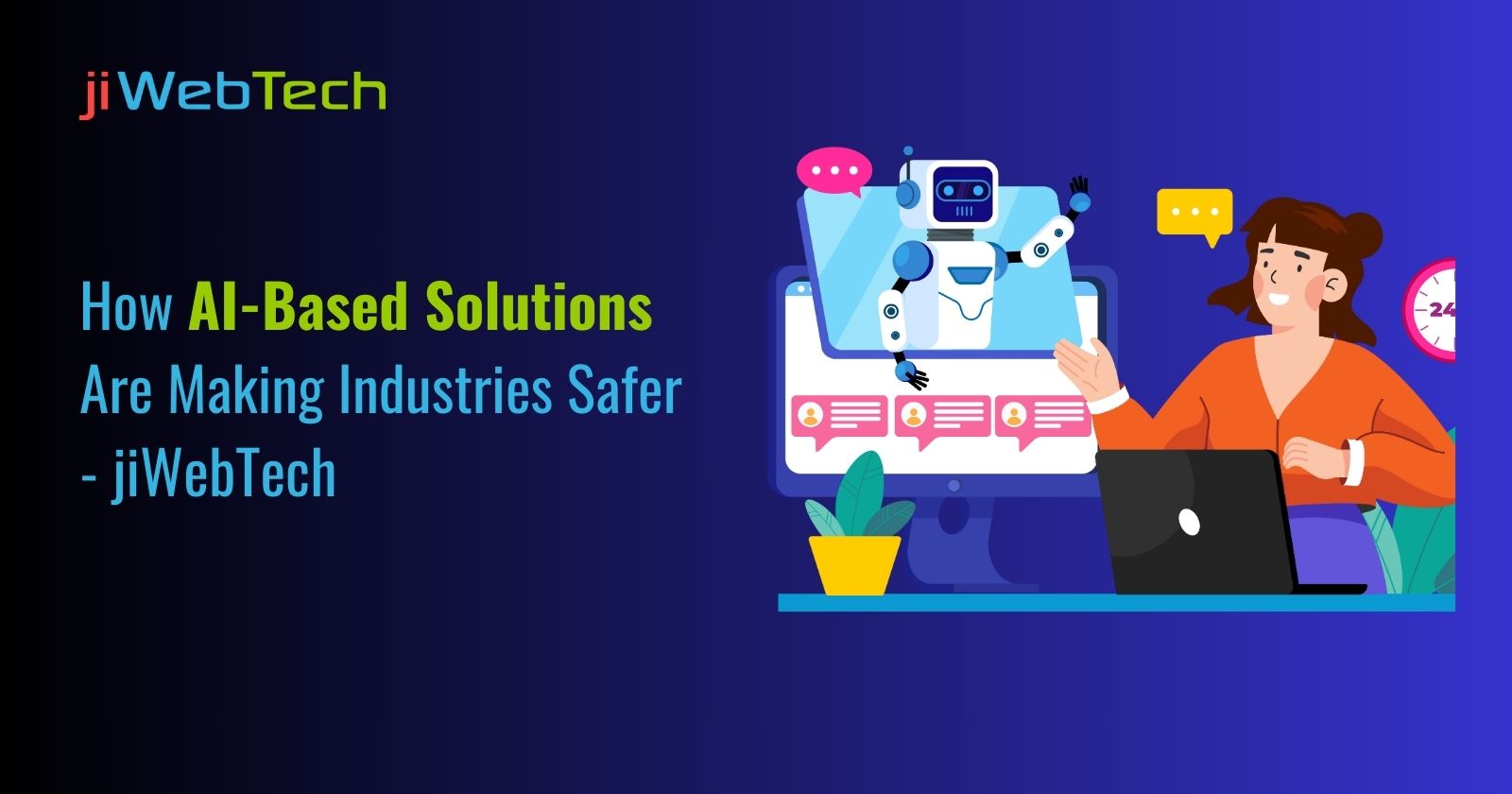Artificial Intelligence (AI) has become a game-changer in enhancing safety across various industries. With AI-driven solutions, businesses can predict, prevent, and respond to potential hazards efficiently. At jiWebTech, we recognize the importance of AI in creating safer workplaces and industrial environments. This blog explores how AI-based solutions are transforming industry safety.
1. AI in Workplace Safety
AI-powered safety systems help organizations identify risks before they lead to accidents. Smart surveillance systems, wearable sensors, and predictive analytics enable real-time monitoring and hazard detection. By analyzing data patterns, AI can alert workers and managers about potential dangers, ensuring preventive measures are taken on time.
Key Features:
- Computer Vision: AI-powered cameras detect unsafe behaviors such as not wearing safety gear or entering restricted areas.
- Predictive Maintenance: AI analyzes equipment performance and predicts failures before they occur, reducing workplace accidents.
- Automated Alerts: AI-driven monitoring tools send instant alerts to employees in case of safety breaches.
- Smart Helmets and Wearables: AI-enabled helmets monitor environmental conditions and worker health, ensuring timely safety interventions.
2. AI in Manufacturing Safety
Manufacturing industries face numerous risks, including machinery malfunctions, human errors, and hazardous material handling. AI-based robotics and automation minimize these risks by performing dangerous tasks with precision.
AI Solutions:
- Collaborative Robots (Cobots): These AI-driven robots work alongside humans, handling high-risk tasks safely.
- Quality Control: AI detects defects in products, reducing the chances of faulty machinery causing accidents.
- Safety Training Simulations: AI-driven VR and AR simulations train workers on safety protocols without real-world risks.
- Automated Safety Protocols: AI-powered systems ensure compliance with industrial safety regulations by monitoring worker behavior and machine operations.
3. AI in Construction Safety
The construction industry is one of the most hazardous sectors. AI-driven tools are enhancing safety by analyzing worksite conditions and ensuring compliance with safety regulations.
AI Applications:
- Drones for Site Monitoring: AI-powered drones inspect construction sites for structural weaknesses and unsafe working conditions.
- Worker Fatigue Detection: AI-powered wearables track worker fatigue levels, reducing the risk of accidents due to exhaustion.
- AI-Enabled Risk Assessment: Machine learning models assess risk levels based on environmental conditions and worker behavior.
- AI-Powered Site Planning: AI algorithms analyze construction blueprints and real-time data to identify potential risks before work begins.
- Automated Machinery Monitoring: AI tracks the performance of heavy machinery, predicting potential failures and preventing accidents.
4. AI in Healthcare Safety
AI is playing a crucial role in improving patient safety and medical procedures. From robotic surgeries to AI-assisted diagnostics, the healthcare sector benefits immensely from AI-driven solutions.
Safety Enhancements:
- AI-Based Diagnostics: AI helps detect diseases early, reducing misdiagnoses and improving treatment accuracy.
- Medical Robotics: AI-powered robots assist in surgeries, minimizing human errors.
- Patient Monitoring Systems: AI continuously monitors patients’ vital signs, sending alerts in case of abnormalities.
- AI-Powered Drug Safety Monitoring: AI assesses potential side effects and interactions in medications, ensuring patient safety.
- AI-Enhanced Emergency Response: AI-powered systems predict and allocate medical resources efficiently during emergencies.
5. AI in Transportation Safety
AI is making transportation safer through smart traffic management, autonomous vehicles, and predictive maintenance in aviation and logistics.
AI Solutions:
- Autonomous Vehicles: AI-powered self-driving cars reduce human errors, leading to fewer accidents.
- Traffic Prediction & Management: AI analyzes traffic data to optimize routes and reduce congestion.
- Driver Assistance Systems: AI-enabled systems monitor driver behavior, preventing drowsiness-related accidents.
- AI in Aviation Safety: AI helps in aircraft maintenance, predicting mechanical failures before they cause safety hazards.
- AI in Railway Safety: AI-driven monitoring tools track rail conditions and train movements, preventing collisions and derailments.
- AI-Powered Cargo Management: AI enhances cargo security by detecting potential safety threats in shipping and logistics.
6. AI in Oil & Gas Industry Safety
The oil and gas industry involves hazardous operations that can lead to severe accidents. AI helps enhance safety through predictive analytics, automated inspections, and real-time monitoring.
AI Innovations:
- Leak Detection Systems: AI-powered sensors detect gas leaks early, preventing explosions and environmental hazards.
- Predictive Maintenance for Equipment: AI predicts pipeline and equipment failures, allowing timely repairs.
- AI-Enhanced Fire Safety: AI systems analyze environmental factors to detect and respond to fire hazards quickly.
- Autonomous Drones for Inspection: AI-driven drones inspect pipelines, offshore rigs, and refineries to identify risks.
7. AI in Mining Safety
Mining is another high-risk industry where AI-based solutions significantly improve safety for workers.
AI Applications:
- AI-Powered Ventilation Systems: AI monitors air quality in underground mines, ensuring safe working conditions.
- Autonomous Drilling Machines: AI-driven robots reduce human exposure to dangerous mining environments.
- Real-Time Hazard Detection: AI sensors detect hazardous gases, unstable surfaces, and potential cave-ins.
- Worker Safety Tracking: AI wearables track miner movements and send alerts in case of accidents.
8. AI in Cybersecurity Safety
With increasing cyber threats, AI is being used to protect industries from cyberattacks that can disrupt operations and compromise safety.
AI-Driven Cybersecurity Measures:
- Threat Detection & Prevention: AI identifies and neutralizes cyber threats in real time.
- Automated Security Audits: AI conducts continuous security audits, detecting vulnerabilities before hackers exploit them.
- AI-Driven Fraud Detection: AI prevents financial fraud and data breaches by monitoring suspicious activities.
- Secure Access Management: AI ensures only authorized personnel can access sensitive industrial systems.
Conclusion
AI-based solutions are revolutionizing industrial safety by predicting and preventing potential hazards. From workplace safety to transportation, healthcare, construction, and cybersecurity, AI-driven technologies are making industries more secure and efficient. At jiWebTech, we leverage AI to develop cutting-edge solutions that enhance safety and improve operational efficiency. Embracing AI in safety management is the key to a safer and smarter future.
FAQs
1. How does AI improve workplace safety? AI improves workplace safety by monitoring real-time conditions, detecting hazards, and sending automated alerts to prevent accidents.
2. Can AI replace human safety inspectors? While AI enhances safety inspections, human oversight is still essential for decision-making and complex risk assessments.
3. How does AI prevent machinery failures? AI uses predictive maintenance algorithms to analyze equipment data, identifying potential failures before they occur.
4. What role do AI-powered wearables play in safety? AI-powered wearables track worker health, fatigue levels, and exposure to hazardous conditions, reducing accident risks.
5. Are AI-driven safety systems expensive? While initial implementation costs may be high, AI-driven safety systems provide long-term savings by reducing accidents and improving efficiency.
6. How does AI contribute to cybersecurity in industries? AI helps detect cyber threats, monitor network security, and prevent data breaches that could compromise industrial safety.
7. Can AI improve emergency response in industrial accidents? Yes, AI enhances emergency response by analyzing real-time data, predicting risk factors, and optimizing resource allocation during crises.
8. How does AI impact transportation safety? AI improves transportation safety through autonomous vehicles, smart traffic management, predictive maintenance, and accident prevention systems.
By integrating AI into safety strategies, businesses can create secure, accident-free environments, ensuring the well-being of employees and the smooth functioning of operations.








